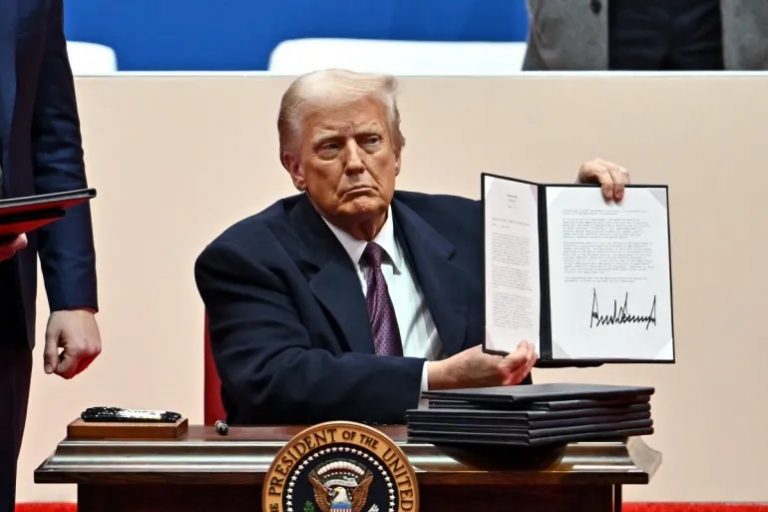
Executive orders have long been a tool used by American presidents to implement programs without the consent of Congress. Even though their immediate effects frequently garner media attention, the way these orders are discussed and argued in public settings, especially on social media like X (previously Twitter), offers important insights into government, political participation, and public awareness. To provide important insights, our analyst analyzes 131 tweets that center on President Donald Trump’s recent executive orders. Eight themes that provide more comprehensive insights into the perception of executive authority in the United States of America were developed from 70 of the total tweets.
Themes Emerging from the Conversation

Explanation of Executive Orders. Our analysis shows a notable segment of tweets that focused on explaining what executive orders are, their purpose, and their limitations. According to our analyst, this indicates the place of X through the users in educating the public about the US Executive Orders, demonstrating an ongoing need for civic education, as many people remain unclear about the legal foundation and boundaries of EOs. For the world, this stresses the critical role of transparency in governance and the necessity of ensuring citizens understand the tools wielded by their leaders.
Lists or Examples of EOs. Some users of X also deployed their knowledge capability to itemise a series of EOs that have been issued by President Trump to inform the public. This theme stresses the demand for accessible information, as individuals and organizations seek clarity on how executive actions may impact them. For international audiences, this reflects the importance of publicizing government actions in a way that is easily digestible and widely accessible.
Register for Tekedia Mini-MBA edition 19 (Feb 9 – May 2, 2026): big discounts for early bird.
Tekedia AI in Business Masterclass opens registrations.
Join Tekedia Capital Syndicate and co-invest in great global startups.
Register for Tekedia AI Lab: From Technical Design to Deployment (next edition begins Jan 24 2026).
Political Impact and Criticism. The political ramifications of executive orders dominated the conversation, with users debating their effects, expressing criticism or praise, and questioning their motivations. This theme reveals the polarizing nature of EOs, which can be seen as both a demonstration of leadership and an overreach of authority. For other nations, it serves as a reminder of the balance needed between executive power and democratic accountability.
Legal and Constitutional Challenges. Legal debates surrounding executive orders also featured prominently. Discussions on whether certain EOs align with constitutional provisions indicate the importance of checks and balances in governance. The legal scrutiny observed in the U.S. offers lessons for countries worldwide about the necessity of robust judicial systems to hold leaders accountable.
Tracking Resources. A smaller but significant portion of tweets shared resources for tracking and understanding executive orders. This indicates a growing demand for tools that make government actions more transparent. Globally, this emphasizes the need for open governance and data-driven accountability mechanisms that empower citizens to stay informed.
Specific Policies in EOs. Many tweets highlighted the policies covered by executive orders, such as immigration, climate change, or healthcare. This reflects a public desire to engage with substantive issues rather than abstract political manoeuvring. For other governments, it illustrates the importance of communicating policy priorities clearly and linking executive actions to tangible outcomes.
International Impact of EOs. Some tweets discussed how U.S. executive orders affect international relations, particularly on issues like trade, immigration, and climate agreements. This emphasises the global ripple effects of American policy decisions and the interconnectedness of modern governance. Countries can learn from this about the importance of considering international consequences when crafting domestic policies.
Miscellaneous or Unclear Context. The largest category, comprising tweets with unclear or unrelated content, demonstrates the noise that often accompanies online discussions. While not directly insightful, this category reminds governments and communicators of the challenges in cutting through misinformation and ensuring accurate narratives dominate public discourse.
Lessons for the World
One of the most striking takeaways is the necessity for clear explanations and accessible information about executive actions. Executive orders are powerful tools that can shape policies, address crises, and drive immediate action. However, their effectiveness depends on public understanding. Citizens must grasp the purpose and implications of these orders. Governments worldwide should view this as a call to invest in civic education. By equipping citizens with the knowledge to understand executive tools, leaders can foster a more informed and engaged populace. Transparent communication about governance builds trust, reduces confusion, and strengthens the democratic fabric of society.
The public’s demand for tracking resources and discussions about specific policies reveals a strong desire to engage with governance. This reflects a universal principle: people want to be active participants in the decisions that shape their lives. Leaders must prioritize open communication and actively involve citizens in policymaking processes. Such engagement creates a bridge between governments and the governed, ensuring policies are not just top-down directives but collaborative solutions.
While executive authority can be indispensable in addressing urgent issues, it must be exercised responsibly. Legislative and judicial bodies play a crucial role in checking this authority to prevent overreach and maintain democratic integrity. This principle of checks and balances is not only relevant to the U.S. but to all nations striving for accountable governance. The interplay between executive, legislative, and judicial branches ensures that power is not concentrated but distributed in a manner that safeguards democracy. Governments must uphold this equilibrium to inspire confidence in their institutions.



